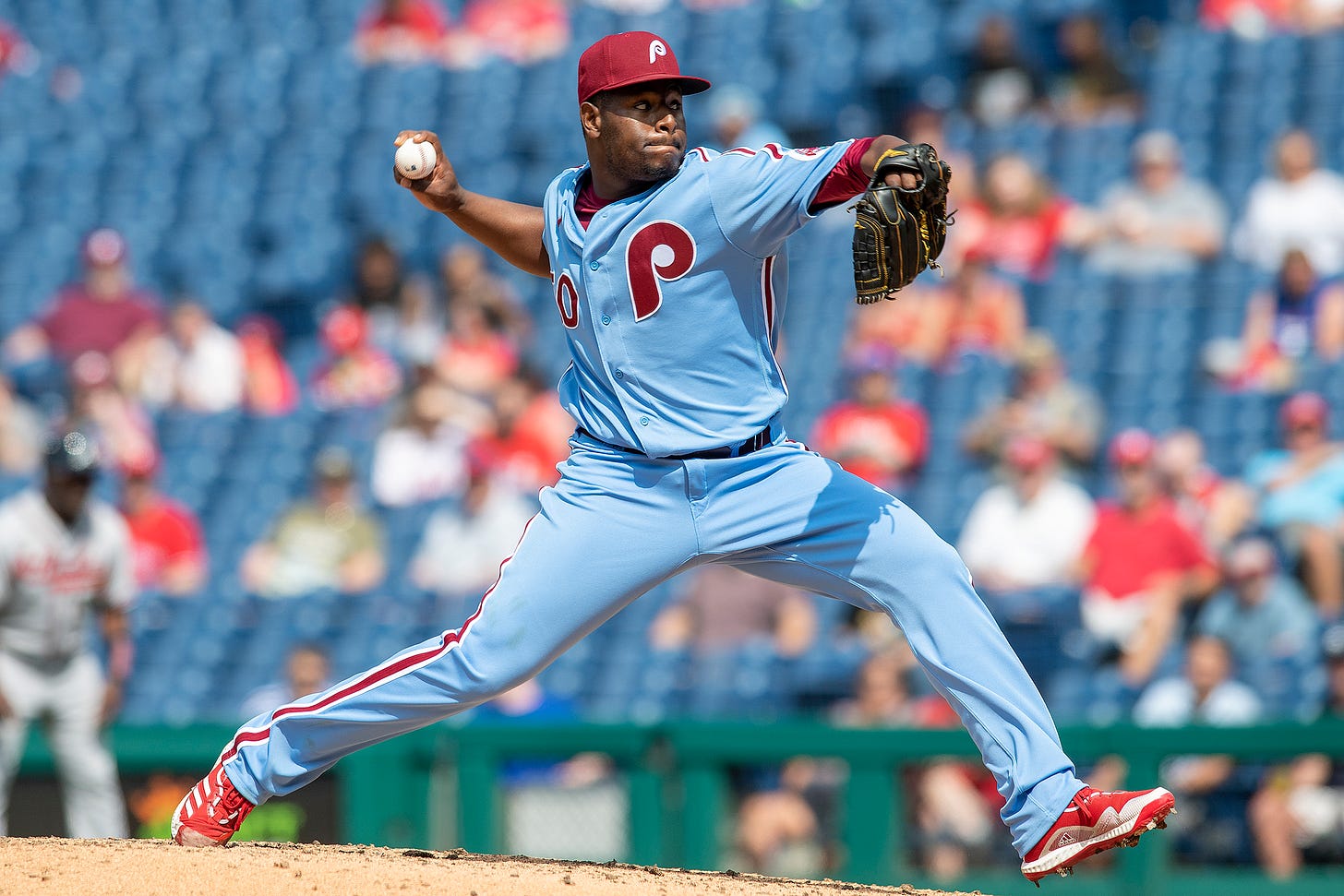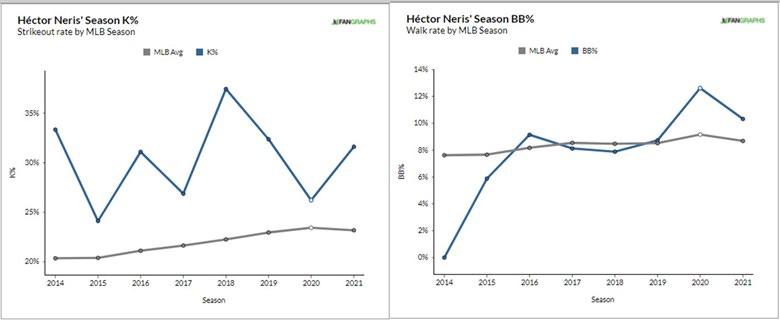Is Hector Neris Worth $17 Million
A Review of the Strengths and Weaknesses of the Astros Newest Reliever, and the Opportunity Costs of Signing Him Over Other Options
Word leaked yesterday that the Astros had agreed to a 2 year/$17 million contract with Hector Neris. The Astros had both the need for more help in their bullpen and space in their payroll to sign a free agent reliever.
Neris is a player with a clear strength—he brings high strikeout and chase rates to Houston. But he’s never seemed to take the next step as a pitcher, and he was never able to cement himself into the closer’s job in a Phillies bullpen that constantly had an opening for him. He’s a talented player, and yet, the commitment to Neris by the Astros seems larger than his talents.
I’ll explore Neris’s the player, discussing his strengths and weaknesses on the mound. Then I’ll discuss his new contract, where the Astros made an aggressive move for him despite having a number of bullpen alternatives available for a similar or lesser price on the free agent market.
The Player
Neris has pitched his entire career up to now with the Phillies, debuting in 2014 and establishing himself as a late inning option in late 2015. Over his career, he has a 3.42 ERA in 405 appearances, all out of the bullpen. While his ERA has bounced up and down (a low of 2.58 in 2016 and a high of 5.10 in 2018), his FIP has been more consistent. He’s usually been a few tenths above or below his career FIP of 3.79.
These are good, but not great numbers. Neris is able to strike batters out, and he’s averaged 11.5 K/9 over his career. His walk numbers are OK, with 3.3 walks per nine.
The chart below shows Neris’s K% and BB% by season over the course of his career. You can see that his strikeout rate has remained well above league average. But his walk rate has increased over the course of his career. It was near league average from 2016-2019, but has increased in his last two seasons.
You can get a sense from these charts of why Neris’s talents, but also why he’s never fully put it together to become a full-time closer.
Neris’s Statcast numbers from 2021 help show why he was attractive to the Astros. Red numbers are good and Neris has a lot of them. He is in the 93rd percentile in whiff and chase rates, which lead to a 91st percentile rating in K%. Neris’s best pitch is a splitter, which he threw 40.6% of the time in 2021, and which induced a whiff % among opposing batters of 45.6%.
Neris’s swing and miss stuff helped him produce 90th percentile marks in xwOBA, xERA, and xSLG. Neris was able to strike a lot of batters out, and, as a result, produce numbers that should have made him one of the best relievers in the league.
But Neris’s worst numbers were his walk rate. Neris walked 10.3% of the batters that he faced in 2021, which was at the 23rd percentile of all major league pitchers. In short, he’s allowing too many baserunners.
A look at Neris’s career numbers show that the patterns shown in the 2021 numbers have been there throughout Neris’s career. He has consistently had excellent whiff rates, and, as a result, his numbers on expected stats are in the red—which means they are above league average. But his walk rate is always in the blue—which means it is below league average.
Neris also has given up home run rates near the league average. He gave up 1.45 Home Runs per 9 innings in 2021 and 1.30 for his career. The Astros are likely to target Neris against RHBs, which will bring the Crawford Boxes into play frequently when Neris is on the mound at Minute Maid Park.
Overall, Neris is a good player, who can help the Astros in the bullpen, especially when they need a strikeout. But his walk rate is higher than anyone will like, and that has gotten higher over the course of his career.
The Contract
The most surprising element of the Neris signing was him getting a second guaranteed year in his contract. On Friday, I wrote that the front office was worried about adding guaranteed money to their payroll in 2023, and on Saturday, the added guaranteed money to their payroll in 2023. I guess I got that one wrong.
But what I didn’t get wrong was that the payroll is likely to go up in 2023. The Astros now have approximately $188 million committed to 16 players that season, and will still need to replace or re-sign Michael Brantley and Yuli Gurriel in the lineup.
Perhaps the Astros plan to pay the luxury tax in 2023. Or perhaps their spending on 2023 is an indication that luxury tax threshold will rise above its current level of $210 million. Well, that’s the hope anyway.
The biggest cost to Neris though is the opportunity cost of signing him over a number of alternatives. The chart below comes from Roster Resource’s Free Agent Tracker. I filtered the list for relief pitchers and then sorted by projected fWAR for the 2022 season.
Raisel Iglesias stands out as the best reliever on the market, but after that is a large group of relievers projected between 0.6 and 0.4 bWAR. You can a number of relievers on the list who seem to be similar to Neris in overall value. There’s old friend Collin McHugh; Jake Diekman, formerly of the As’ who you will recall from the 6,000 times he’s been brought in to face Michael Brantley is on the list. So is one time Brewers closer Corey Knebel. Heck, there’s the bullpen villain of the 2020 season—Joe Kelly—and the bullpen villain of the 2021 season—Ryan Tepera. There’s even another Luis Garcia, who we could sign to create confusion.
The point of this list is that the Astros—as a team with money to spend and who had an opening for a set-up man—had a number of options in the free agent bullpen market. They could have waited until after the lockout to let the market come to them and offer either the same contract or a less generous one (say making the second year a club option) and signed any of these relievers.
The opportunity cost makes me reticent to endorse the Neris signing. The Astros likely could have gotten a pitcher of similar talents for less of a financial commitment had they waited longer into the offseason to sign one. It’s certainly possible that they will still do this.
But the fact that the front office was aggressive in signing Neris when they had other options tells me that their evaluation is that Neris is better than the rest of this pack. They see his put away split finger pitch and low expected batting average and wOBA numbers as big assets. They think that with a better defense behind him (and the Phillies seem to play every one of their players one position too far up on the defensive spectrum), Neris will produce more outs. And they can live with an occasional ball finding the Crawford Boxes.
Hector Neris will be a key member of the Astros bullpen for the next two seasons. Let’s hope that the front office’s positive evaluation of his skills is right.








